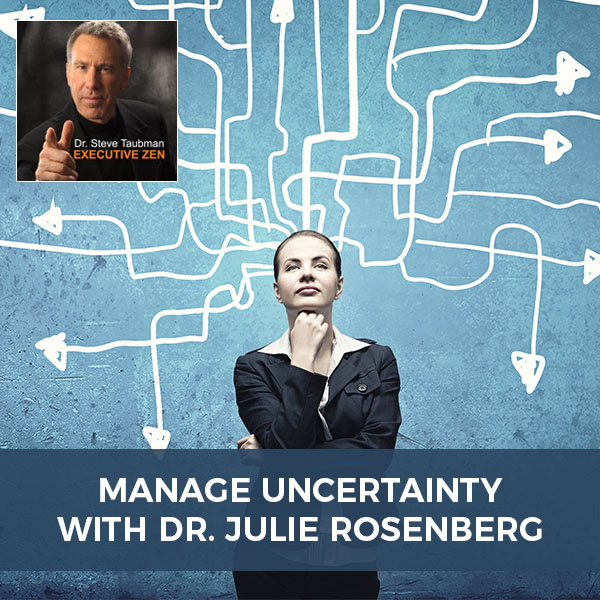
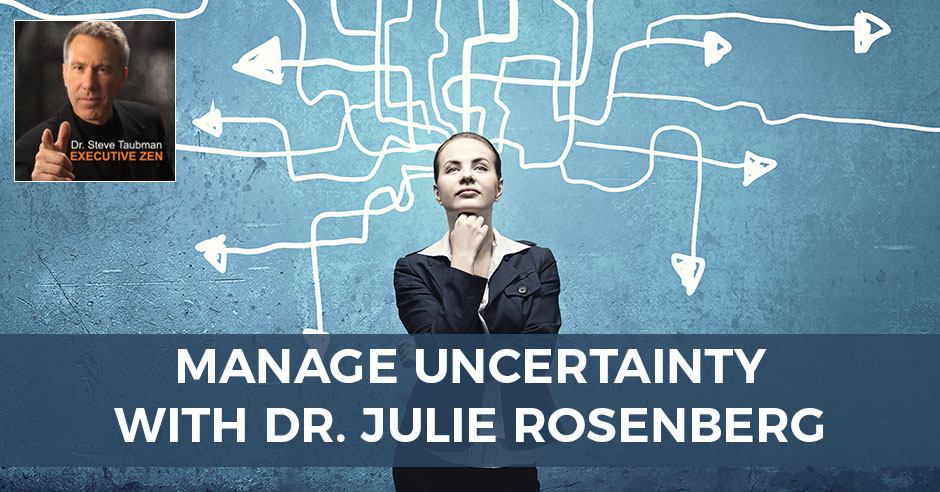
Uncertainty is somewhat the norm in business. In fact, one of the few things that we can be certain about is that we’re going to experience uncertainty. Yet most of us have come unglued when we face the unpredictable. It stresses us out. What it comes down to is that things can either turn out good or bad. We’re equally likely to have things in one way or the other, but we’re much more likely to envision the bad. We fret and worry about negative outcomes rather than to relax into the image of the outcome that we want. As we look forward into our future, not only should we prepare for the eventualities that will come in the external worlds, but we need to prepare ourselves internally to meet the uncertainty that we will inevitably face. Dr. Julie Rosenberg, executive coach, global healthcare leader, and bestselling author, speaks on how to apply mindfulness in business and gives some pointers on how you can manage uncertainty.
—
Listen to the podcast here:
Manage Uncertainty with Dr. Julie Rosenberg
I’m excited about this episode’s topic, which is managing uncertainty. Our guest is an expert in this area and a kindred spirit. I want to provide some context. Uncertainty is somewhat the norm in business. In fact, one of the few things that we can be certain about is that we’re going to experience uncertainty, yet most of us have come unglued when we face the unpredictable. It stresses us out. What it comes down to is that things can either turn out good or bad. We’re equally likely to have things in one way or the other, but we’re much more likely to envision the latter, the bad, and then to fret and worry about negative outcomes rather than to relax into the image of the outcome that we want. This brings up a curious question about how we focus our attention and where we put our minds and whether or not we’re doing ourselves any favors by focusing on the negative.
This may be a survival thing. We’ve been programmed since caveman days to see the worst and to be prepared for the worst. It’s better to know about that saber-toothed tiger than to sit around the fire without a stick. We’re always recognizing the possibility of disaster and being ready for it. In our world today, the disasters are not real disasters to the same extent. There are things that feel like it seemed like disasters are often simply disappointments. If we prepare for the worst, theoretically we have a leg up, but it doesn’t always work out that way. Sometimes we end up suffering so much over what might be that we can’t enjoy the success that ultimately comes in. By the time it does come, we’re so strung out by our own mental reaction to the uncertainty of the outcome that we don’t get the full benefit of the victory.
Is this good? Is it bad? Is it just programming? Where do we stand on things like the power of positive thinking? Should we be thinking more positively? Does that have any impact? We did a whole show on this that I’d encourage you to go back to one of my Facebook Lives on the question of a positive thinking, Law of Attraction, manifestation and whether or not there’s any validity to that idea. I’m not here to talk woo-woo stuff with you. I’m here to suggest that maybe our mental state has some an impact even if that mental impact is not magical or mystical. It’s simply maybe practical, how we feel, how we’re being and what that does in terms of the results that we’re getting.
In my work as a mindfulness coach, I come from the perspective that whenever outcomes are unpredictable, we are far better off working on our inner game than exhausting ourselves trying to figure out in advance what we’re going to do when the poop hits the fan. That’s not to say that it’s not a good idea to have a battle flag plan and to have contingencies. At the same time, we need to work on ourselves to stay flexible and light on our feet. Part of preparing for uncertainty is preparing to know what to do with our own reaction to it.
One of the few things that we can be certain about is that we're going to experience uncertainty. Click To TweetAs we look forward into our future, not only should we prepare for the eventualities that will come in the external worlds, but we need to prepare for what we’re likely to experience on the inside. What we do with that experience on the inside can have a major effect on how the outer experience turns out. It’s a matter of trusting us to be ready for anything. If I’m adequately flexible, resourceful and unattached, I can respond more quickly to changing circumstances than I could if I had sat around anticipating crises without practicing any inner process at all.
Let me try to give you an analogy to this so you can get what I’m saying here and you don’t think I’m suggesting that you go into a different mindset to the exclusion of externals. In football, there are plays and strategies but it’s just as important that the player remain alert, agile and flexible. This is all a function of mindfulness. It’s a function of being self-aware, being in one’s body, being in the moment, and being present. Research shows us that the mindful professional has a greater capacity to meet the demands of an uncertain marketplace than the mindless over planner. You can plan all you want, but if you haven’t done any of the work, that could be detrimental to your wellbeing and the wellbeing of your business. It will dissipate your ability to meet uncertainty.
We’re going to explore this question of how we can prepare ourselves internally to meet the uncertainty that we will inevitably face. I have got the perfect guest for this conversation. I’ll be speaking with a well-respected expert and bestselling author on the topic of applying mindfulness in business. In particular, how it influences our capacity to manage uncertainty. Hopefully, she’ll set me straight about my pre-ramble. I will come up with ideas to improve your business, your capacity to meet the legitimate demands of your work. The second segment is going to be an important one and there’ll be a lot of value to take away with you.
—
I’m thrilled to be introducing my guest. Julie Rosenberg, MD is a pharmaceutical executive and global healthcare leader. She’s also an executive coach who helps successful leaders get even better by developing themselves and their people and by embracing a more conscious living. Dr. Rosenberg has devoted the last sixteen years to the in-depth study of the practice of yoga and meditation. Her work demonstrates the millennia-old physical, mental, and spiritual discipline of yoga. She not only supports good health and wellbeing but also helps strengthen one’s personal and professional leadership skills. That’s the power of this experience. I’m so glad to have her as a guest.
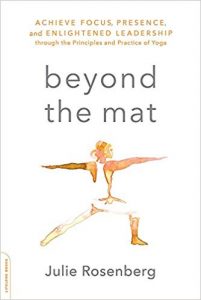
Beyond the Mat: Achieve Focus, Presence, and Enlightened Leadership through the Principles and Practice of Yoga
In 2017, Julie was selected among 16,000 applicants by number one executive coach and leadership thinker, Dr. Marshall Goldsmith, as one of the MG 100. That’s a group of over 100 ninja warriors on the battlefield with consciousness, leading coaches, thinkers, senior business leaders, each of whom is committed to paying it forward. Her book is called Beyond the Mat. It’s been called transformative, insightful, practical, accessible, creative and more. It’s a great read.
On a personal note, I’ve had a couple conversations with Julie. Our messages are so in sync. Beyond the Mat shares with Buddha In The Trenches a commitment to showing you how to take your mindfulness practices like meditation and yoga off the mat into the real world and determining with the transformative strategies for your business. Please welcome, Dr. Julie Rosenberg. Julie, how are you?
I’m good. Thanks, Steve, for having me on this show. We’re two peas in a pod. I like Buddha In The Trenches and I am glad that you appreciate Beyond the Mat. We have a chance to share a few thoughts with your audience.
I get so many guests speaking on so many different elements of success and mindset, but of all my guests, you and I are probably the most in-sync and most align in terms of the message that we’re bringing to our community. You’ve been doing it very successfully and at a very high level. I’m thrilled to have you here. You probably do have a fair amount of traveling in the work you do. Where have you been doing lately?
For work, I travel mostly within the states, but occasionally abroad. I do a fair amount of work traveling in the Asian region. I’m working on a big project with our group in China. That necessitates a lot of late hours and evening hours. The motto today is no longer, “Work-life balance.” It’s, “Work-life integration.” It’s how we integrate our work into the framework of our lives so that we can enjoy both.
I remember reading Tim Ferris’ book, The 4-Hour Workweek. He was coming from the perspective that, “Wouldn’t it be great if our lives are maintained a certain amount of integration in such a way that we were enjoying our work and enjoying our regular lives? Then continuing along the way doing a balance and integration of those two things so that we weren’t waiting to retire to finally take a breath.”
Realistically, it’s not the situation of four hours per se is the optimal work week. Some people can, but not everyone. However, we can manage our lives and our works on a continuum. We’re going to be better off. I would suggest even so doing that we’re going to miss less because we accept that as a part of life and we move forward from that premise and that framework.
In other words, we don’t have to wait until the end of the workday to finally do our practices or find serenity or any of that, but rather, we can use the work itself and frame it in such a way that we’re getting value even while we’re doing it.
There are a lot of examples about that that I can offer, but one of the things that I think about meditation-type practice or mindfulness practice is, “How do you use that at the moment?” One of my favorite parts of the practice is what I call The Pause because there are so many situations in corporate life or even in life in general where one might react. Somebody says something and you don’t like it or you’re upset about it. You may be inclined to say something that you’re going to regret later. One way to avoid that is to try to be present at the moment and take a breath. Then your level of reactivity may drop significantly and your ability to respond more intelligibly, unconsciously at the moment is much better.
I thoroughly enjoyed your book and it resonates so much with the intent of Buddha In the Trenches. The idea of taking yoga or meditation practice into our lives seem so obvious. What you’re saying right now is that there are simple practices at the moment that can bring mindfulness into the experience of being upset and being overwhelmed and being caught off guard, but few people do it. Why is that?
I’m not sure why they don’t do it. For myself, let me take the opposite stance for a moment. I found it so effective that it’s a path forward in any type of business setting. It’s been helpful for me in managing two global teams and an interface program with China. People may not do it because there’s skeptical. People, especially in the West, are still skeptical goal that eastern practices are not something that’s alternative and that people who are weird might do them. The proof is in the pudding. Try it. My suggestion for all the skeptics is to try it, but you have to have a foundation to be able to try it and use it effectively. The integration of Eastern and Western practices is critical not only in medicine but in Corporate America and in any type of business.
We’re seeing this more and more among high-pressure professionals and people who were working at the highest echelons are beginning to take on mindfulness practices and recognize their value. Are you seeing more of that as you do the work you do?
I have to acknowledge that I’ve worked in the pharmaceutical industry and it is an industry that historically is fairly slow to change. I, myself, am somewhat of an outlier in this industry because I’m connected across many different businesses. I do see this a lot more among high-level professionals. There’s a willingness, attitude and aptitude that allows for better resilience in work based on the implementation of these types of mindfulness practices.
In your book, there were a number of wonderful allusions to how to bring this stuff off the mat. I’m going to refer to Chapter Six where you talk about becoming present to the challenge. What you went into in that chapter that stood out is that you were talking about multitasking and how so many Americans, business people, and Westerners have come to believe that you’re going to be more effective if you do a lot of things at once. The converse of that is something I’m not sure if the Pali or Sanskrit word Dharana, but it means to focus and concentrate fully on a single task. Can you talk a little bit about that aspect of the process?
First of all, that’s one of the yoga sutras. There’s a reality that people multitask are blown over by the amount of information and the amount of pull that we have come from so many directions. That’s not just in business people, but also in our general lives. Multitasking is a myth. The brain cannot focus in so many different directions. We need to stay focused on one activity at a time. By doing so, our level of engagement increases and we’re able to complete such a task with greater ease and with greater effectiveness. When we try to focus all over the place, it’s a problem.
One of the things that I personally avoid is what they call it in my company, the office communicator. It’s that little text message that we can use at the office. I find that I could be having three or four conversations if I have that on. Those conversations detract from my ability to do what I’m doing primarily with greater effectiveness and greater ease. I see this all the time. I’ll be in a meeting that would be hosted by a Webex. I might be leading such a meeting and I’ll ask someone who I think is engaged to question, they have no idea what I asked. We multiply that by numerous people who are doing many different things when we’re trying to focus on one critical priority.
Multitasking is not an effective way of getting things done. People couldn’t catch themselves where they didn’t achieve a focus or awareness of what was going on at that moment. They were so busy either thinking about something else, doing something else or trying to accomplish several goals at once, which isn’t going to work well.
Multi-tasking is a myth. The brain cannot focus in so many different directions. We need to stay focused on one activity at a time. Click To TweetMany things popped into my head when you said that, which is ironic. There’s multitasking where I’m in a meeting, but I’m also checking my email or I’m checking my texts. It’s still multitasking if the thing that you’re doing while you’re in that meeting is thinking about something else. It’s not necessarily doing. It could be a thinking. You could be multitasking and not look like you’re multitasking. Does that make sense?
It does. The doing is easier to step up than the thinking. At the end of the day, if we’re thinking about other things, one of the things that our mindfulness practice does, and this is something that folks need to learn, is to help us think in a focused manner. To be conscious, aware and present in the current moment so we can pay attention to where we are, what we’re doing, and what our feelings and sensations are in that moment rather than being all over the place. If folks can start with getting rid of the actual act of things they’re doing, the task, then the thinking part of it can come next. I believe that is more of a practice phenomenon. It’s very important that you don’t have your thoughts running all over the place or you will miss the present moment there as well.
In the prior chapter, you talk about Pratyahara. In emphasizing the word practicing, we, as Western people with very busy minds, have a tendency to have a hard time and be very uncomfortable about the experience of silence. It does require practice to become comfortable with the idea of having a mind that’s focused on a single task, thought or silence itself rather than running amok.
Getting back to this idea of practice, how do you encourage the people that you teach and empower to practice silence? It’s profoundly uncomfortable for people not used to it, “I’m used to having my brain working all the time and when there’s a potential gap in my thinking and things for me to do, I panic.” That’s is a common experience. People rush for Facebook or email, they rush for something else to fill up the silence. They rush to the refrigerator because of sadness and discomfort. How do you get comfortable with silence because it’s such a fundamental part of this?
Let me start with the outcome. The way I’ve been able to get people to even respond to these types of views is that I try to run teams. I’m generally fairly successful in doing that. I’m trying to promote this, not in a yoga studio or a meditation studio, but on the job with people that I work with in very high-stress and demanding environments. We get results. The question is, “How do we get those results?” Some of those results need to come from freeing ourselves from distraction. I encourage people first to try to keep focused on the task at hand and then try to rid themselves of distraction.
Sometimes in our silence, we can find a more creative voice. I share some of this with my team. I encourage people to utilize those moments of silence and start small. Don’t start with an hour of silence. Start with five minutes of undistracted time. You might find that those creative thoughts come within those undistracted times. It helps you, just breathing and being in some quietude, to not only be creative but to also abort what might be a usual fight or flight response. We spend so much of our working time and even our waking time worrying about the fact that we’ve got so much to do. A few moments of silence might open so much more space in your mind and even in your body. If you breathe and release that, the work you have to do later will be done with a greater relative ease. Those are a few thoughts on tolerating silence deep. In our Western culture, if we can show that we get the results that we strongly seek and we’re well through that, we have a high state of well-being.

Manage Uncertainty: Multitasking is not an effective way of getting things done.
Evidence rules in this case because you’re fighting an uphill battle against a cultural bias perhaps or fear. Then you take a look at the evidence and the results and you see and demonstrate to your people that if you do this, even though it may seem counterintuitive, it’s going to make your life better. You’re going to feel better. You’re going to be more resourceful, creative and all those other flowers along the path. Tell me a little bit about the people that you are working with. When you run a team, are you primarily speaking to the executives on the team? Are you working with the folks in the trenches? Who’s getting to hear what you’re talking about?
In my business environment, I run two large international teams. My primary job in the pharmaceutical industry is to oversee international drug development programs. The drug development programs that I particularly work on, in my role as a pediatric oncologist, are focused on patients with cancers. It’s a lofty goal. We’re working toward the cure of cancer along with many others. The team is very dedicated to discipline. I have two teams that are working on drugs that support patients with cancer. Hopefully, we’ll have new drug launches. In addition, I have another team that I’m part of. I don’t run it, but I do provide a clinical strategy for a newer team. The folks there are primarily based in China, but we do have global members and we’re doing work that will be implemented in China.
I do have that cross-cultural reach. These things work cross-culturally. On my teams in general, there are multiple folks representing different functions. They might represent medical, operations, project management, administration, and the typical multifunctional teams. I’m not trying to get folks that are in the medical mindset to do this, but I’m trying to get all team members coming from a variety of different disciplines to think about the inherent value and at a minimum, to try it and see if it doesn’t enhance their work life but importantly as well as their personal life.
I can say wholeheartedly that this has been effective within the United States. I run global teams, so it’s been adopted cross-culturally and specifically in the Asian region. I fight an uphill battle sometimes with those above me. We all have bosses and their bosses. Nevertheless, the results do speak for themselves. I hope it is the observation of those results that will, inside even the biggest skeptics, to maybe take a pause and think about if these things are effective. They work for me and they’ve worked for many on my team.
That’s definitely what changed my life and what’s helped with people that I impact. Let me ask you this because you’re very much steeped in the world of business and a lot of the people reading this are as well. A lot of people wonder who are saying, “There’s something here. There’s something that can have an impact on the culture of my company, the resourcefulness of my people, and my ultimate bottom line.” For the people who happen to have some power in their company, how would they start to implement a mindfulness-based program? What would you recommend? Maybe there are some steps along the way. Is there some practical advice you could offer to help somebody take a company that’s never looked at this issue and assuming the person says, “This makes sense, what do I do next?”
Sometimes in our silence, we can find a more creative voice. Click To TweetThis is a big field. I’ve been doing this for years. I know you’ve been doing it for a long time. It’s been an evolution for me and I can say with certainty that my leadership framework is based on this. Whether it’s myself or someone like myself, your readers would benefit from communicating with someone who has expertise in this area in a corporate setting and someone who might be able to advise as to how to implement such a framework. It’s multi-factorial and it has many different steps to do it in an entire organizational culture. However, at the individual level, there are many good mindfulness centers and there are many good coaches that can help with meditation, mindfulness, and yoga practices.
That’s how I got into coaching. It wasn’t my intention to be an official coach, but I was so involved in the aspects of leadership that necessitated coaching and mentoring. I wanted to get some credentialing around that. The individual can hire a coach or a mentor or seek out classes for mindfulness and meditation. Once one has the grounding in those areas, then it becomes useful to think about how to do this more expansively. I wouldn’t try to engage something so robust as to shift a corporate culture without having a clear understanding of it myself as to how this works and how it’s effective. Then they should seek out a support as for how this might be effective in a broader group setting.
There’s nothing worse than developing a program without having the buy-in and understanding yourself. I would discourage anybody from trying to develop a mindfulness-based culture if they themselves have already embraced the idea of mindfulness and haven’t already done some of the inner work so that they can experience firsthand the benefits. That would certainly have to be step one.
It starts with the individual and then it evolves to the team level and the corporate level for one who is working in such a setting. Even for entrepreneurs and small business owners, this is highly applicable. Despite the fact that I believe I have a very robust knowledge in drug development, I am absolutely confident that how I lead myself through the vicissitudes of corporate life, managing a team and even myself at home will be tantamount to my overall success individually and collectively.
We’ve got a curious group of people who are beginning to tiptoe into the world of mindfulness. They perhaps get what you’re saying, “I can see how Steve, Julie, and people who have embraced this are applying it in their lives and it’s making them into better leaders. I want to be a better leader. I want to become more mindful and practicing and get a coach. I’m going to become more mindful of myself and start applying these principles. I want to bring it to the team level.” What does that look like? Is that, “Let’s get a team together and let’s teach them how to meditate or having a weekly meditation room that we encourage people to use,” or is there anything at that next level that you might suggest so we can start envisioning the roadmap toward a mindful company?
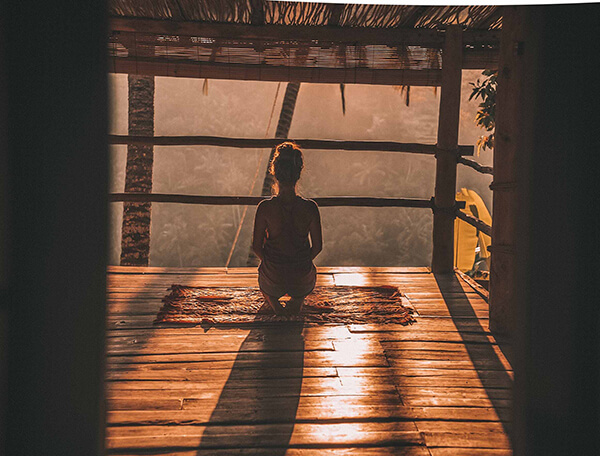
Manage Uncertainty: There are many good mindfulness centers and there are many good coaches that can help with meditation, mindfulness, and yoga practices.
First of all, it is helpful to have meditation rooms and areas where people may experience some quietude such as sitting rooms. It could be the same as a meditation room, but it might be different such as a sitting room and they could have soft music or books. There are areas where one can go for some quietude. What can be offered is in the day-to-day. Having that understanding of the things that I tried to outline in Beyond the Mat, I use the yoga sutras as a metaphor for optimal leading and living. Having that understanding about non-distraction, the benefit of focus and breath work in calming down, and the benefit of the pause, having a coach that may be helpful to you in reflecting on some of the things that occurred during the day, week or month depending on how often one might have a coaching engagement, that’s fairly useful.
Everyone’s not going to have a coach, but some companies do meditation experts either ad hoc that can be called upon or within the framework of the company or they have folks that can work with people to help them to integrate into the daily life. It’s the foundation that starts first. What I’m trying to offer might be a little more advanced than the foundation. In most urban areas and in some other areas, there are certainly meditation centers, yoga facilities and the like. It’s very popular. Getting it to that next level is where we need that coaching, personal reflection, and reading the literature as to how we might do it. This is a lofty goal, but I hope I’ve shared a few useful thoughts with your audience and it needs to start with the one and then it can travel to the many.
“Physician heal thyself.” I’ve got a friend who says, “Therapy is only as high as your therapist.” If you think of the analogy of the doctor or the CEO or the doctor of your company, you’ve got to first heal yourself. You’ve got to first develop mindfulness. Then you bring that into the work you do both in terms of how you empower and communicate with your people, but also in terms of how you teach them to do the same thing you’re doing. You’re essentially looking for willing participants and people who are willing to embrace a new way of being. You’re giving them an opportunity to do it. You’re giving them a place to do it. You’re giving them some classes. Do you go out and teach in companies other than your own like workshops or speeches for a company and begin to help them to structure their mindfulness practice and culture?
I do a number of keynotes on this topic and I enjoy it. I do some corporate consulting because I work full-time in drug development as well. This, at the moment, is more of a passion of mine that I’ve found it’s so effective that if I can help spread the word, I love to do that. I enjoy helping corporations transform. Even something like a keynote talk at a corporation that has some good materials that people can adapt can be so helpful in shifting behaviors and dynamic. The proof is in the results. I do love to help people one on one as a corporate consultant and, as a keynote speaker, to be able to improve along these lines, see for themselves the overarching value, and see that value in business results.
If you want to learn more about Julie and her work, you could go to JulieRosenbergMD.com. You can visit her website and see a bit of what our world looks like. I encourage you to take a look at her book, Beyond the Mat, which I believe you can get right off the website. Am I right about that, Julie?
You can get it on the website. It’s widely available on the online booksellers as well as in your local bookstore. For those who think they don’t have time to read, it is available as an audiobook, the Kindle edition.
Is the audiobook in your voice?
It’s not my voice. We did have a professional read the book. It’s read by Caroline Cook, but it’s all the various components. I like to read the book. The book is effective if one reads it because I give a lot of exercises and things you can do. We’re all busy professionals. I don’t take busy for an answer. I give a lot of things you can do in two minutes and it’s good to take a look at those. I also give some reflection questions and I’m coming out with a discussion guide that will be free and available on my website soon for the book. The book is a good guide for many of the things we talked about.
Practicing gratitude improves your mood by enhancing your feelings about optimism, joy, and pleasure. Click To TweetThe things that stood out for me about the book were the exercises, the thinking points, and the way that you encourage people to make it more than something to dump into their heads, but to take it out in the real world. I appreciated that a lot about the book. I encourage you to take a look at beyond that. You mentioned something about National Yoga Month giveaway. Is that something still happening and if so, do you want to say something about that?
September is National Yoga Month. I’m not necessarily trying to get everybody out into a yoga studio, but what I would love to see is for everybody to adopt these principles of practice. There is a foundation called Give Back Yoga. It’s a great group. It helps marginalized individuals to be able to live and lead in a better way. It’s not dissimilar to the way that we’re talking about. I am giving a large percentage of profits from Beyond the Mat throughout September to Give Back Yoga. You will be not only supporting yourself but supporting a good cause. Why not start now to shift the dynamic, live and lead in a more mindful?
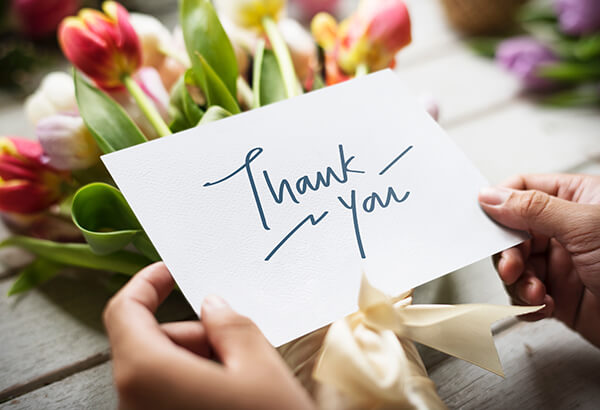
Manage Uncertainty: Practicing gratitude is one of the most reliable methods for increasing content and satisfaction.
I want to encourage people in the sense that procrastination, the delaying of action, is not a mindful stance. One of the first things you could do to start improving your mindfulness is to simply follow through on things it sounds like they’re worthy of you and to do them now. What that does is it helps to emancipate you from the habitual things that keep you from taking action. When we’re mindful, we’re self-aware. We’re not bound by the way our brains lead us down the wrong path where we see it, we rise above it. Rise above your complacency, hesitancy, procrastination and take action. That will be in your best interest.
We end our shows with a metaphor, quote and challenge for the week. In a traditional sense, I look around my head for a metaphor that reflects what we’ve been talking about and I look for a quote I feel is particularly meaningful. I ask my guests to share a challenge, something to which I believe Julie is highly suited. The metaphor for today that came to me was simply a scale. I was thinking in terms of balance, not like, “Do I do as much of this as I do of that?” but, “Am I balanced as a human being? Am I emotionally balanced? Are you giving an equal amount of creatives to your inner world as your outer world? Are you aware of what it feels like inside of you? Are you conscious of your being?” Take that metaphor with you and see if your scale is balanced. That would be my recommendation for a metaphor.
The quote that I wanted to share with you is based on the idea of uncertainty, which we didn’t talk specifically about but we alluded to it. I was reading some of the work of Chesley Sullenberger, he was the guy who landed the plane on the river. He said, “Not every situation can be foreseen or anticipated. There isn’t a checklist for everything.” Going back to this idea that as we enter into our worlds and we try to master the challenges that we face, recognize that you can’t foresee and anticipate every situation because there isn’t a checklist for everything. What you can do is to be more mindful, to be more self-aware, quieter, more present, more silent, and therefore to meet the situation with grace, discernment and produce the best possible outcome. With that, I’m going to turn this over to Julie to share a challenge for the week.
What I want the readers to think about this is the gratitude. Practicing gratitude is one of the most reliable methods for increasing your content and satisfaction. It also improves your mood by enhancing your feelings about optimism, joy, pleasure and it can reduce anxiety. This is a very big science. The science of gratitude. The challenge for your readers is to get a small journal, if you don’t already have one, and keep it by your bedside. When you get up in the morning, and this just takes a minute, think about three things for which you are grateful. Write them down and then go about your day as you otherwise would. Before you go to bed, reflect on those three things just for a moment.
I’m not asking for more than two minutes of time, morning and night. Do that for a week and then review it and see how you feel. Talk about it with your loved ones or friends and see if this doesn’t, in some way, change your perspective. We’ve got so many things that go on in our environment that one could perceive as negative. What are you grateful for each day?
The science behind that is indisputable. Our happiness index rises when we bring gratitude to the table. It’s a simple exercise, so I encourage you all to do it well. Thank you very much for joining us. It’s been a lot of fun having this conversation. When we return next episode, my guest will be Emmy Award-winning executive producer, Kelly Lou Dennis. We’ll be talking about authenticity. Share this with your friends, subscribe to my podcast, visit iTunes, find my channel, Executive Zen. Thanks again for reading. You can join me on my Facebook Live program. Remember to lead consciously and profit responsibly.
Important Links:
- Julie Rosenberg, MD
- Beyond the Mat
- Buddha In The Trenches
- The 4-Hour Workweek
- JulieRosenbergMD.com
- Give Back Yoga
- Executive Zen on iTunes
About Dr. Julie Rosenberg

Julie Rosenberg is a physician executive who works in the pharmaceutical industry where she oversees a multi-million-dollar global drug development program. In addition, Julie has devoted the last 15 years to the in-depth study and practice of yoga. She received her advanced teaching certification from Down Under Yoga in Boston in 2015, under the tutelage of Natasha Rizopoulos. In 2017, she was selected by Number 1 executive coach and leadership thinker Marshall Goldsmith from among 16,000 applicants as one of the MG 100 coaches. Enthusiastic and passionate about helping people ensure good health for life and quality of survival, Julie has become a highly sought-after keynote speaker for corporations, patient groups, and premier resorts and health spas. She lives in Connecticut and Florida. Beyond the Mat is her first book.